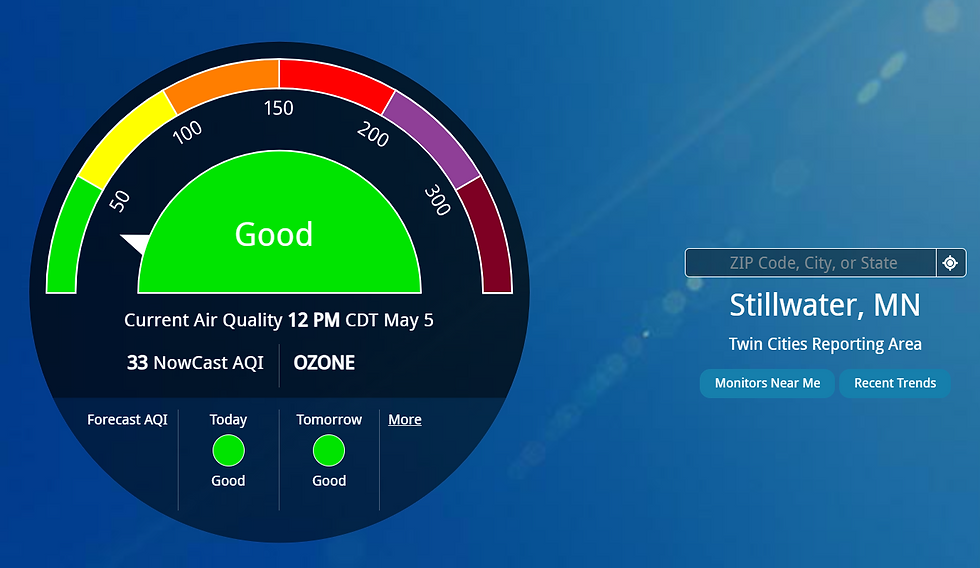Breathe Easier: Stay Air Aware During Air Quality Awareness Week (May 5–9)
- Sustainable Stillwater MN

- May 5
- 3 min read
This week, we're joining the U.S. Environmental Protection Agency (EPA), the Minnesota Department of Health (MDH), and organizations across the country to observe Air Quality Awareness Week — a time to highlight the importance of clean air and share practical ways to stay healthy when the air isn’t.
The 2025 theme is “Stay Air Aware” — a simple reminder that knowing your local air conditions can help you make smart decisions for your health and the health of your family.

Why Air Quality Matters More Than Ever
Unhealthy air affects everyone, but it’s especially harmful to children, older adults, and people with asthma, heart disease, or other chronic conditions. According to the American Heart Association, even short-term exposure to air pollution can trigger heart attacks, strokes, and breathing problems.
Minnesota’s air quality can be impacted by wildfires, vehicle emissions, and even lawn equipment. In fact, asthma-related ER visits in the Twin Cities are more than five times higher in BIPOC communities compared to other areas. That’s why staying informed and prepared is key — for everyone.
How to “Stay Air Aware”: 10 Tips to Protect Yourself from Unhealthy Air
1. Check the air quality daily. Before heading outside, visit AirNow.gov or download the AirNow app for real-time updates specific to Minnesota. You can also visit the MPCA’s current air quality page.
2. Avoid strenuous outdoor activity when air quality is poor. If it’s an orange, red, or purple air quality day, move workouts indoors and keep kids’ outdoor play short and light.
3. Conserve energy at home. Less energy use = less pollution. Simple steps like turning off lights, using energy-efficient appliances, and adjusting your thermostat can make a big difference.
4. Reduce school bus emissions. Encourage local schools to cut down on idling and explore cleaner transportation with programs like the EPA’s Clean School Bus initiative.
5. Drive less. Bike, walk, carpool, or use public transit when you can. Fewer cars on the road mean cleaner air for all of us.
6. Skip the burn.
Avoid burning wood or trash, especially on days when the air quality is already compromised. These activities release fine particles that can deeply harm lungs and hearts.
7. Choose cleaner yard tools. Gas-powered mowers and blowers contribute significantly to local air pollution. Switch to electric or manual tools to protect both the planet and your lungs.
8. Be smoke ready. Wildfire season is here. Stock up on N95 masks, air purifiers, and make an emergency plan. Learn more at the Be Smoke Ready website.
9. Don’t forget indoor air quality. Ventilate when cooking, avoid smoking indoors, and use HEPA filters in your HVAC system or air purifiers to improve indoor air.
10. Speak up. Support policies that prioritize clean air at the local, state, and national levels. Visit the American Lung Association’s Healthy Air Campaign to get involved.
Special Focus: Asthma and Youth Health
May is also Asthma Awareness Month. Environmental triggers — especially poor air quality — are a major contributor to asthma attacks. The MDH provides guidance to help keep kids active while protecting their lungs, including when to modify outdoor activities during air pollution events like wildfire smoke. If you’re a coach, teacher, or youth leader, check out MDH’s free online training: Athletes and Asthma: The Community Coach's Role.
Take the First Step Today
Start by checking the air quality in Stillwater. Visit AirNow.gov, use the AirNow mobile app, or follow the Minnesota Pollution Control Agency for updates.
Follow the Minnesota Department of Health on Facebook, Instagram, X (Twitter), and LinkedIn for helpful air quality tips and resources throughout the week.
Let’s work together to keep Stillwater’s air clean and our community healthy. Every breath matters.
Sources:
300_edited.png)








Comments